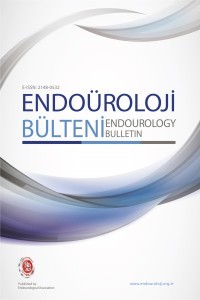Üroloji pratiğinde acil perkütan nefrostominin yeri; tek merkez deneyimi
Obstrüktif üropati, Hidronefroz, Perkütan nefrostomi, Komplikasyon
Place of emergency percutaneous nephrostomy in urology practice: single center experience
___
- Florido C, Herren JL, Pandhi MB, Niemeyer MM. Emergent Percutaneous Nephrostomy for Pyonephrosis: A Primer for the On-Call Interventional Radiologist. Semin Intervent Radiol. 2020;37(1):74-84. doi:10.1055/s-0039-3401842
- Zul Khairul Azwadi I, Norhayati MN, Abdullah MS. Percutaneous nephrostomy versus retrograde ureteral stenting for acute upper obstructive uropathy: a systematic review and meta-analysis. Sci Rep. 2021 Mar 23;11(1):6613. doi: 10.1038/s41598-021-86136-y.
- Balasubramanian A, Metcalfe MJ, Wagenheim G, Xiao L, Papadopoulos J, Navai N, Davis JW, Karam JA, Kamat AM, Wood CG, Dinney CP, Matin SF. Salvage topical therapy for upper tract urothelial carcinoma. World J Urol. 2018 Dec;36(12):2027-2034. doi: 10.1007/s00345-018-2349-9
- Farrell TA, Hicks ME. A review of radiologically guided percutaneous nephrostomies in 303 patients. J Vasc Interv Radiol. 1997 Sep-Oct;8(5):769-74. doi: 10.1016/s1051-0443(97)70658-4
- Young M, Leslie SW. Percutaneous Nephrostomy. 2021 Aug 13. In: StatPearls [Internet]. Treasure Island (FL): StatPearls Publishing; 2022 Jan–.
- Dyer RB, Regan JD, Kavanagh PV, Khatod EG, Chen MY, Zagoria RJ. Percutaneous nephrostomy with extensions of the technique: step by step. Radiographics. 2002 May-Jun;22(3):503-25. doi: 10.1148/radiographics.22.3.g02ma19503.
- ACR–SIR–SPR Practice Parameter for the Performance of Percutaneous Nephrostomy Res. 20 – 2016 Available at: https://www.acr.org/-/media/ACR/Files/Practice-Parameters/Percutaneous-Nephros.pdf Accessed February 10 2022
- Valji, K., Maroney, T.P. Vascular and Interventional Radiology. Shock, 1999,12 (5).
- GOODWIN WE, CASEY WC, WOOLF W. Percutaneous trocar (needle) nephrostomy in hydronephrosis. J Am Med Assoc. 1955 Mar 12;157(11):891-4.
- Radecka E, Magnusson A. Complications associated with percutaneous nephrostomies. A retrospective study. Acta Radiol. 2004;45(2):184–8.
- Efesoy O, Saylam B, Bozlu M, Çayan S, Akbay E. The results of ultrasound-guided percutaneous nephrostomy tube placement for obstructive uropathy: A single-centre 10-year experience. Turk J Urol. 2018 Jul;44(4):329-334. doi: 10.5152/tud.2018.25205.
- Pabon-Ramos WM, Dariushnia SR, Walker TG, d'Othée BJ, Ganguli S, Midia M, Siddiqi N, Kalva SP, Nikolic B; Society of InterventionalRadiologyStandards of PracticeCommittee. QualityImprovementGuidelinesforPercutaneousNephrostomy. J VascIntervRadiol. 2016 Mar;27(3):410-4. doi: 10.1016/j.jvir.2015.11.045.
- Yoo MJ, Bridwell RE, Inman BL, Henderson JD, Long B. Approach to nephrostomy tubes in the emergency department. Am J Emerg Med. 2021 Dec; 50:592-596. doi: 10.1016/j.ajem.2021.09.034.
- Ali SM, Mehmood K, Faiq SM, Ali B, Naqvi SA, Rizvi AU. Frequency of complications in image guided percutaneous nephrostomy. J Pak Med Assoc. 2013 Jul;63(7):816-20.
- Kehinde EO, Newland CJ, Terry TR, Watkin EM, Butt Z. Percutaneous nephrostomies. Br J Urol. 1993 Jun;71(6):664-6. doi: 10.1111/j.1464-410x.1993.tb16061.x.
- Sood, G., A. Sood, A. Jindal, et al. Ultrasound guided percutaneous nephrostomy for obstructive uropathy in benign and malignant diseases. Int braz j urol 2006 32(3): p.281–286.
- Bird VG, Fallon B, Winfield HN. Practice patterns in the treatment of large renal stones. J Endourol/Endourol Soc. 2003; 17:355–363.
- Lee CL, Anderson JK, Monga M. Residency training in percutaneous renal access: does it affect urological practice? J Urol. 2004 Feb;171(2 Pt 1):592-5. doi: 10.1097/01.ju.0000104849.25168.6d.
- Cobb KD, Gomella PT, DiBianco JM, Batter TH, Eisner BH, Mufarrij PW. Are Emergently Placed Nephrostomy Tubes Suitable for Subsequent Percutaneous Endoscopic Renal Surgery? Urology. 2019 Apr; 126:45-48. doi: 10.1016/j.urology.2019.01.006.
- Matsuura H, Arase S, Hori Y. Ureteral stents for malignant extrinsic ureteral obstruction: outcomes and factors predicting stent failure. Int J Clin Oncol. 2019 Mar;24(3):306-312. doi: 10.1007/s10147-018-1348-6.
- Prentice J, Amer T, Tasleem A, Aboumarzouk O. Malignant ureteric obstruction decompression: how much gain for how much pain? A narrative review. J R Soc Med. 2018 Apr;111(4):125-135. doi: 10.1177/0141076818766725.
- Folkard SS, Banerjee S, Menzies-Wilson R, Reason J, Psallidas E, Clissold E, Al-Mushatat A, Chaudhri S, Green JSA. Percutaneous nephrostomy in obstructing pelvic malignancy does not facilitate further oncological treatment. Int Urol Nephrol. 2020 Sep;52(9):1625-1628. doi: 10.1007/s11255-020-02466-2.
- Wong LM, Cleeve LK, Milner AD, Pitman AG. Malignant ureteral obstruction: outcomes after intervention. Have things changed? J Urol. 2007 Jul;178(1):178-83; discussion 183. doi: 10.1016/j.juro.2007.03.026.
- Garg G, Bansal N, Singh M, Sankhwar SN. Role of Percutaneous Nephrostomy in Bladder Carcinoma with Obstructive Uropathy: A Story Revisited. Indian J Palliat Care. 2019 Jan-Mar;25(1):53-56. doi: 10.4103/IJPC.IJPC_102_18.
- Noegroho BS, Kurniawan AP, Wijayanti Z, Mustafa A. Factors Affecting Survival Outcome After Percutaneous Nephrostomy as Palliative Urinary Diversion in Obstructive Uropathy due to Advance Cervical Cancer Patients. Asian Pac J Cancer Prev. 2021 Apr 1;22(4):1211-1216. doi: 10.31557/APJCP.2021.22.4.1211.
- Chalmers N, Jones K, Drinkwater K, Uberoi R, Tawn J. The UK nephrostomy audit. Can a voluntary registry produce robust performance data? Clin Radiol. 2008 Aug;63(8):888-94. doi: 10.1016/j.crad.2007.10.021.
- Degirmenci T, Gunlusoy B, Kozacioglu Z, Arslan M, Ceylan Y, Ors B, Minareci S. Utilization of a modified Clavien Classification System in reporting complications after ultrasound-guided percutaneous nephrostomy tube placement: comparison to standard Society of Interventional Radiology practice guidelines. Urology. 2013 Jun;81(6):1161-7. doi: 10.1016/j.urology.2013.02.038.
- Wah TM, Weston MJ, Irving HC. Percutaneous nephrostomy insertion: outcome data from a prospective multi-operator study at a UK training centre. Clin Radiol. 2004 Mar;59(3):255-61. doi: 10.1016/j.crad.2003.10.021.
- Krohmer, S. J., Pillai, A. K., Guevara, C. J., Bones, B. L., &Dickey, K. W. (2018). Image-GuidedNephrostomyInterventions: How toRecognize, Avoid, orGetOut of Trouble. Techniques in vascularandinterventionalradiology, 21(4), 261–266. https://doi.org/10.1053/j.tvir.2018.07.008.
- Montvilas P, Solvig J, Johansen TE. Single-centre review of radiologically guided percutaneous nephrostomy using "mixed" technique: success and complication rates. Eur J Radiol. 2011 Nov;80(2):553-8. doi: 10.1016/j.ejrad.2011.01.109.
- Carrafiello G, Laganà D, Mangini M, Lumia D, Recaldini C, Bacuzzi A, Marconi A, Mira A, Cuffari S, Fugazzola C. Complications of percutaneous nephrostomy in the treatment of malignant ureteral obstructions: single-centre review. Radiol Med. 2006 Jun;111(4):562-71. English, Italian. doi: 10.1007/s11547-006-0051-2.
- Yayın Aralığı: 3
- Başlangıç: 2020
- Yayıncı: Pera Yayıncılık
Üroloji pratiğinde acil perkütan nefrostominin yeri; tek merkez deneyimi
Adem TUNÇEKİN, Mehmet DEMİR, Eyyup Sabri PELİT, İsmail YAĞMUR, Bülent KATI, İbrahim Halil ALBAYRAK, Halil ÇİFTÇİ
Taha UÇAR, Mithat EKŞİ, Ferhat KESER, Mesrur Selçuk SILAY, Gokhan ATİS, Asıf YILDIRIM, Turhan ÇAŞKURLU
Retrograde intrarenal cerrahide taşsızlık oranlarını etkileyen faktörler
Uğur ÖZTÜRK, Emrah KÜÇÜK, Mehmet ÖZEN, Mustafa Koray KIRDAĞ, Turgut SERDAŞ, Varol NALÇACIOĞLU, Mustafa AYDIN, Mustafa Kemal ATİLLA
